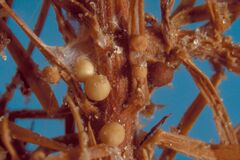Biology:Agroathelia
| Agroathelia | |
|---|---|

| |
| Scientific classification | |
| Kingdom: | |
| Division: | |
| Class: | |
| Order: | |
| Family: | |
| Genus: | Agroathelia Redhead & Mullineux (2023)
|
| Type species | |
| Agroathelia rolfsii (Sacc.) Redhead & Mullineux (2023)
| |
| Synonyms | |
|
Sclerotium rolfsii Sacc. (1911) | |
Agroathelia is a fungal genus[1] currently consisting of one widespread and two other species. Agroathelia rolfsii,[1] the type species, causes serious diseases of cultivated crops such as tomatoes, potatoes, peanuts, bell peppers, and sweet potatoes among many other hosts.[2] It is better known under the names Sclerotium rolfsii or Athelia rolfsii. [2][3]
Agroathelia coffeicola, also known as Sclerotium coffeicola, infects coffee leaves and beans in South America and on various other plants in Central America and the Caribbean, while Agroathelia delphinii, also known as Sclerotium delphinii, attacks numerous plants, including Delphinium after which it was named.[1]
Agroathelia is a member of the Amylocorticiales rather than the Atheliales[4] where it had been placed previously[5][6][7] The genus is characterized by the production of brownish, mustard seed-sized or larger sclerotia with diagnostic polyhedron-shaped cortical cells. They have 4-spored, clavate basidia, nonamyloid, ellipsoid basidiospores and a smooth hymenium. Basidia are rarely observed in nature. [3]
Etymology
Agro- (Greek, agrós, "field") and Athelia (a genus of corticioid fungi), in reference to its resemblance to the corticioid genus of fungi, Athelia and its occurrence in agricultural fields.
References
- ↑ 1.0 1.1 1.2 "Nomenclatural novelties". Index Fungorum 554: 1. 2023.
- ↑ 2.0 2.1 "Stem rot and other diseases caused by Sclerotium rolfsii". North Carolina Agricultural Experimental Station. Tech. Bull. 174. 1966.
- ↑ 3.0 3.1 "Systematics and phylogeny of fungi in the Rhizoctonia complex". Bot. Gaz. 139 (4): 454–466. 1978. doi:10.1086/337021.
- ↑ "Phylogenetic placement of plant pathogenic Sclerotium species among teleomorph genera". Mycologia 102 (2): 337–346. 2010. doi:10.3852/08-189. PMID 20361501.
- ↑ "Major clades of Agaricales: a multilocus phylogenetic overview". Mycologia 98 (6): 982–995. 2006. doi:10.1080/15572536.2006.11832627.
- ↑ "Amylocorticiales ord. nov. and Jaapiales ord. nov.: early diverging clades of Agaricomycetidae dominated by corticioid forms". Mycologia 102 (4): 865–880. 2010. doi:10.3852/09-288. PMID 20648753.
- ↑ "Phylogeny and taxonomy of the genus Anomoloma (Amylocorticiales, Basidiomycota).". Mycol. Progress 15. 2016. doi:10.1007/s11557-015-1155-7.
Wikidata ☰ Q121267551 entry
 |

